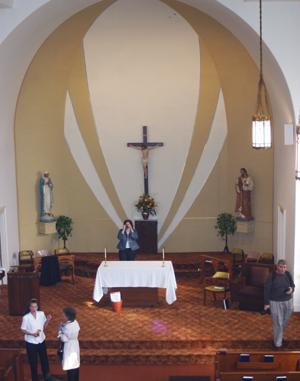
By Celine Klosterman
HARPER – St. Elizabeth Church would soon be closed, but it wouldn’t be the end, Father Robert Harness told more than 200 people Oct. 18.
“You still have the memories,” the former pastor of St. Elizabeth Parish said. He was one of four priests who concelebrated the church’s closing Mass on Sunday and who shared recollections from their time at St. Elizabeth.
Bishop Martin Amos presided at Mass at the 126-year-old church, which Holy Trinity Parish in Keota sold to parishioner Ryan Clarahan for $1 in August. Clarahan will cover demolition costs for the building and plans to build a house where it now stands.
Fr. Harness, now pastor of Holy Family Parish in Davenport, reminded congregants Oct. 18 of the weddings, baptisms, funerals and other events that took place at St. Elizabeth. “But the best memories are of your care and concern for each other,” he told former parishioners. Those memories will last until parishioners are reunited in heaven, he said.
Michael Berg, a Holy Trinity parishioner, drew laughs from sharing recollections of St. Elizabeth School — later converted to the church hall — and of the Sisters who served there.
Catholic education had always been strong at St. Elizabeth, said Father Robert Striegel, former member of the Harper parish. He is now chaplain at Veterans Affairs Medical Center in Iowa City and sacramental minister and canonical pastor for Ss. Joseph & Cabrini Parish in Richland.
Father Robert McAleer said he learned the “greatest skills” of being a pastor at St. Elizabeth, where he first served as pastor. “It’s a great community,” said the current pastor of St. John Vianney Parish in Bettendorf.
The Harper church also marked the site of a first for Father Charles Fladung, who said he was a deacon when he performed his first baptism there. He is now pastor of Holy Trinity and of St. Mary Parish in Sigourney.
St. Elizabeth’s own beginning stretches to 1847, according to a booklet printed for the closing Mass. Then, a priest occasionally visited what is now the Harper area to celebrate Mass and administer sacraments in Catholics’ homes. In 1856, 33 Catholics petitioned Bishop Mathias Loras of Dubuque for permission to build a church and have their own priest. A church was built the following year in Baden and dedicated to St. Elizabeth of Hungary.
In 1883, the church moved to nearby Harper. After Fr. McAleer arrived in 1978, it was renovated.
St. Elizabeth Parish then clustered with Ss. Peter & Paul Parish in Clear Creek in 1979 and, nine years later, with St. Mary Parish in Keota. In 1992, those three parishes merged to become Holy Trinity Parish.
After Holy Trinity clustered with St. Mary’s in Sigourney and Our Lady of Lourdes in Keswick three years ago, St. Elizabeth Church stopped being used for weekend Masses. In June, Holy Trinity’s parish council and finance council determined the church property and contents should be sold and the building demolished.
“Today we take leave of this building, but the Lord comes with us,” Bishop Amos said in his homily. As Catholics prepared to do so, he offered a call to five commitments he said would lead to the crown, but also would include the cross: commitment to love God, to put people and relationships first, to faithfully do small things such as a making a phone call or offering a compliment, to help those in need and to let God love us despite our sinfulness.
He thanked God for St. Elizabeth’s founders, the priests and religious who’d served the parish, the sacraments celebrated there, devotions offered there and the memories.
“St. Elizabeth has been such a place of true Christian community,” Bishop Amos said.
“We had strong family connections to this church,” Maureen Slattery Schebler said after Mass. She recalled visiting St. Elizabeth as a child with her grandparents and father, Maurice Slattery, who’d grown up in the parish. The closing Mass was as much a goodbye to her parents and extended family as to the church, she said.
Similarly, Wilfrid Vittetoe, who grew up in and currently belongs to St. James Parish in Washington, said the visit to St. Elizabeth was nostalgic. As a child, he celebrated Christmas and other events at the church with extended family. “It’s kind of a sad day,” he said of the closing. “But all good things have to come to an end.”








